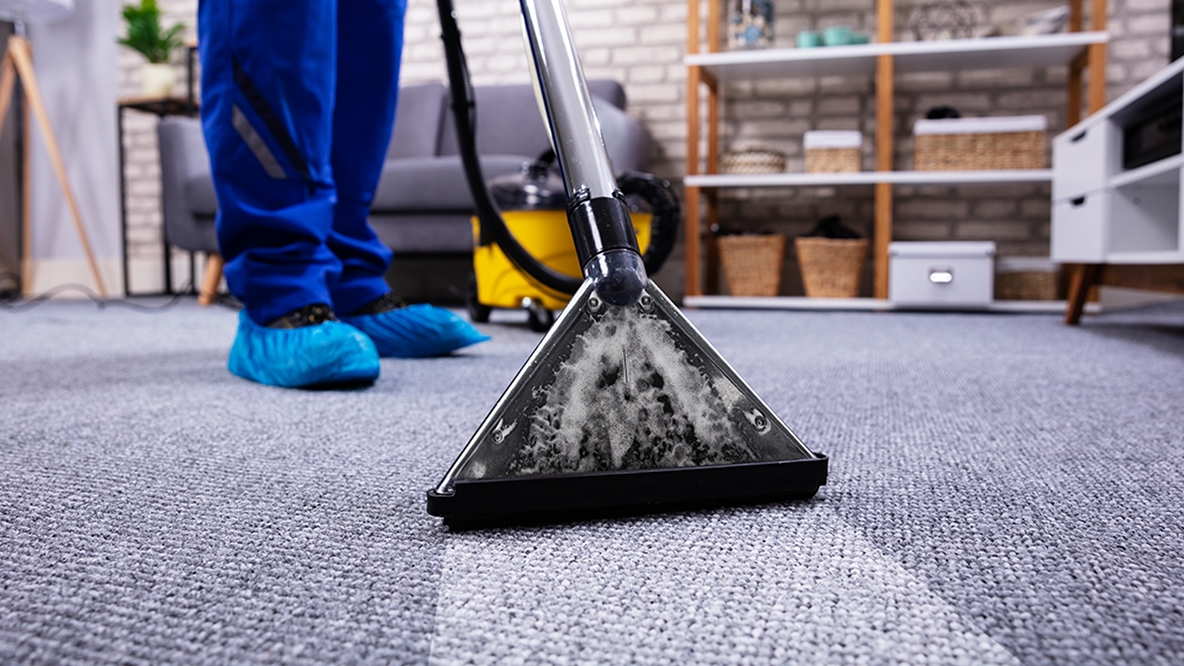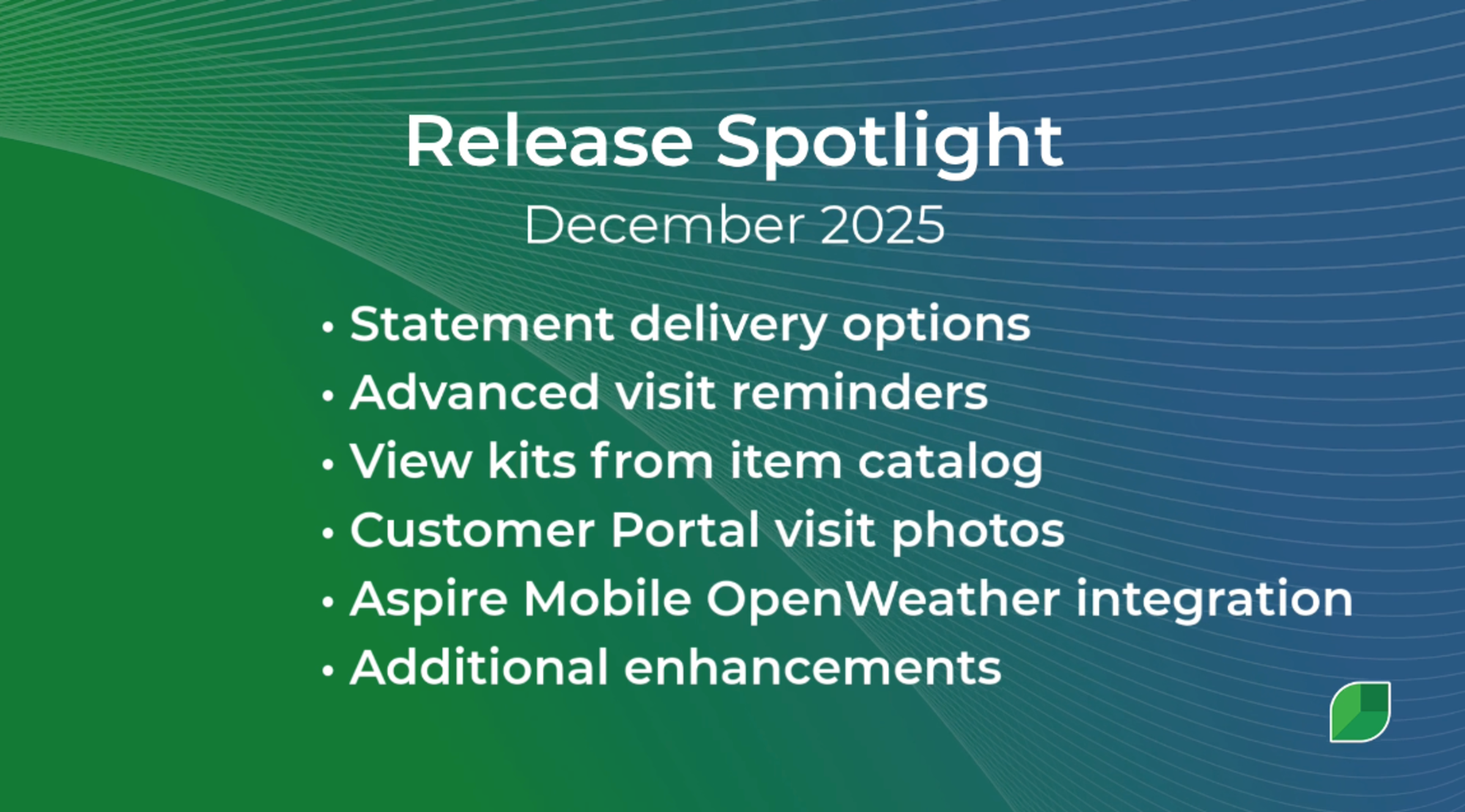Table of Contents
Table of Contents
- Identify and address key pain points
- Mention the benefits of implementing software for cleaning services
- Identifying key stakeholders and their concerns
- Build a business case for cleaning business management software
- Create a plan on how to get leadership buy-in
- Understand leadership’s goals
- Define what success will look like
- Mention the financials
- Find a champion
- Compare solutions
- Preparing for objections and how to handle them
- Report progress
- How to choose the right cleaning business management software
- Introducing Aspire
- Now it’s your turn
Inefficiencies in the cleaning industry, such as missed jobs, poor route optimization, and a lack of visibility into operations, can prevent a business from profitability and growth. Many team members turn to cleaning business management software to improve productivity.
Cleaning business management software is highly scalable, making it excellent for small, growing, and enterprise-level businesses.
However, getting management and business owners to invest in this software can be challenging. This article will give employees and department managers the tools to build a case for getting leadership to buy in.
After all, investing in software is investing in people.
Identify and address key pain points
daily To get management buy-in for implementing cleaning business management software, you must address the pain points that professional cleaning services face that reduce productivity and frustrate employees.
Pain points for cleaning business owners:
Inefficient: Manual scheduling, route optimization, and invoicing slow down the business. Commercial cleaning services can do more and better with software automation, avoiding missed jobs and a failure to meet client expectations.
Missed jobs and poor route optimization: Inefficient scheduling means missed opportunities, delays, and extra costs. Proper software ensures routes are optimized for maximum efficiency, reducing windshield time.
Communication breakdowns: Miscommunication between management and cleaning staff leads to incorrect instructions, delays, and unhappy clients, which can affect customer satisfaction and put the business at risk of losing money.
Lack of data visibility: Without real-time data, business owners have no visibility into job completion rates, employee performance, and overall profitability. Tracking growth and making decisions that drive the bottom line is hard. You can’t merely rely on word-of-mouth referrals for new business.
When you consider these pain points regarding how they affect commercial cleaning companies, you’ll have a solid foundation for the need for cleaning business management software.
Mention the benefits of implementing software for cleaning services
Implementing software for commercial and residential cleaning services provides tangible benefits for companies.
One major benefit is efficiency. Businesses can reduce the hours employees spend on daily tasks by automating scheduling, invoicing, and customer communication.
They can then focus on growing the business, attracting potential customers, and growth marketing strategies.
Another benefit is customer satisfaction. With software, cleaning companies can give clients real-time updates on scheduled services, provide customer portals for scheduling and paying invoices, and track complaints for faster issue resolution.
The software also saves customer preferences so cleaning businesses can tailor services to meet specific needs.
Implementing software will increase revenue. By automating and improving efficiency, companies can take on more clients and offer more services with their existing headcount, which means more revenue and a stronger bottom line.
Software also provides valuable insights through customizable reporting dashboards, enabling companies to identify the most and least profitable services and clients, better allocate resources, and make data-driven decisions focused on growth.
Identifying key stakeholders and their concerns
Typical stakeholders in commercial cleaning companies may include business owners, managers, cleaning staff, and clients.
Business owners
Leadership may be concerned about the software's cost and return on investment. They may also be worried about how easy it is to use and how it will impact existing business processes.
→ Alleviate concerns by showing the long-term benefits and cost savings.
Some business owners may have researched automation before and found that it took more work to find a suitable software solution or to implement it.
Managers
Team leaders may be concerned about how the software will impact their team’s workload and how it will increase efficiency. They may also be more interested in better tracking and managing cleaning schedules and customer communication.
→ Address their concerns by demonstrating how the software will streamline operations and team management.
Cleaning staff and contractors
Individual contributors may be worried about the software's ease of use and how it will increase their workload. They may also be concerned about accessing customer information and communicating with others and wonder whether digital work will replace them.
→ Help team members transition to the new system by providing full training and support and advising them that they can do more if inefficiencies are reduced from their roles, making them more valuable.
Customers
Clients may be concerned about their cleaning schedules, want increased communication, or refrain from using customer portals due to the learning curve in online platforms. They may also want easy access to their cleaning history and the ability to give feedback.
→ Address their concerns by ensuring the software enhances their experience and informs them in real time. Teaching them how to use the customer portal will also improve their experience.
Build a business case for cleaning business management software
Now that you have identified the pain points, you must build a business case showing the tangible benefits of management software, including how it provides end-to-end, integrated functionality for the company.
The goal is to show how this software will not only fix the above issues but also grow the business and retain customers.
A good business case should demonstrably show the following:
Streamlined operations: Cleaning business management software streamlines operations by automating tasks like job scheduling, invoicing, and employee tracking while empowering companies to offer quality services for better resource allocation so the business can acquire new customers and grow.
Visibility and control: Software gives cleaning business owners real-time access to key data, such as job completion, employee performance, and customer satisfaction. Using custom reporting dashboards, owners can make informed decisions to improve profitability and productivity.
Scalability: As cleaning businesses grow from startups to larger corporations, efficient management becomes more critical. A software solution allows companies to scale their operations seamlessly, whether expanding into new markets, discovering new services, or taking on more clients for residential, carpet cleaning, or window cleaning services.
Cost savings: Cleaning business management software saves costs by automating and reducing human error. Inefficiencies in invoicing and job scheduling directly impact the bottom line and free up resources for other uses, such as investing in more cleaning supplies or marketing.
Once your business case covers the above points, leadership will understand the long-term value of the software investment.
Create a plan on how to get leadership buy-in
Now that you have a solid business case, you need a plan to get leadership to invest in cleaning business management software.
This plan should align with leadership’s goals and clearly show how the software will benefit the business overall.
Understand leadership’s goals
Leadership often focuses on key objectives like increasing efficiency, growing the business, and improving profitability.
Align your pitch with these goals by showing how the software will grow the business through automation, better task management, and improved customer satisfaction. Focus on making your pitch resonate with decision-makers, as it will show how the software will streamline daily operations for janitorial, residential, and commercial cleaning services.
How will the software increase productivity and reduce costs?
How will improved efficiency and job tracking lead to higher customer retention and satisfaction?
How will the business grow by being able to scale and take on more clients?
Define what success will look like
Clearly define how you will measure success once the software is implemented. Metrics like time saved on scheduling, reduced errors in invoicing, increased job completion rates, and use of special cleaning methods will resonate with leadership.
Success could be:
Less scheduling errors.
Increase in client satisfaction due to better communication.
More jobs per week with the same workforce.
Less missed appointments.
Increase in client and employee retention rates.
Improved cash flow through fewer lost or overlooked invoices.
Analyze KPIs against a previous period to show improvement. Also, include information that relates to these workflows. This could be in the form of customer reviews, data from the software, or social media screenshots.
Mention the financials
Leadership will want to know how the software will impact the business financially. Make sure to show how the software will impact the bottom line:
ROI: Compare the cost of the software implementation to the savings from automation, reduced errors, and increased business capacity to show the return on investment.
Cost efficiency: Show how the software reduces waste through better use of cleaning products, improved route planning, or more efficient employee management.
Save money: Reduce waste like fuel for poorly planned routes, over-purchase cleaning supplies, or over-staffed jobs.
Improve invoicing: Process payments so they are collected promptly and accurately.
Increase revenue: Better client retention and taking on more jobs without increasing overhead costs.
A financial breakdown, including ROI, will give leadership the confidence the software is a good investment.
Tip: Show specific case studies from Aspire or other successful cleaning businesses that have used software to improve their financials.
Find a champion
Find a champion within your business to increase the chances of getting buy-in. This person should influence leadership and understand the cleaning team's day-to-day challenges.
A champion could be:
A department head fed up with inefficiencies.
A manager who has experienced communication breakdowns.
Someone with influence who can lobby for the software to leadership.
An internal supporter will help you build momentum and get key decision-makers on board.
Compare solutions
When talking to leadership about cleaning business management software, compare the top options. Sites like Capterra or Software Advice can help you evaluate the different solutions. Focus on:
Scheduling and invoicing automation.
Real-time data and reporting are used to track key business metrics.
Integration with existing cleaning industry tools like employee management systems or digital marketing platforms.
Support and training tools
Preparing for objections and how to handle them
Leadership will have concerns about cost, implementation, or disruption to current processes. Address these concerns by preparing answers:
Cost: Emphasize the long-term savings, such as reduced admin overhead and improved job scheduling. Show how the software will reduce operational costs, primarily by automating routine tasks, so your team can focus on more valuable revenue-growing activities. Remind them that investing in people is imperative to retaining staff.
Implementation: Most cleaning business management software, like Aspire, integrates easily with current systems and offers comprehensive training programs to get the team up to speed quickly.
Disruption: Show that adopting new software will reduce disruption by automating many manual processes that cause delays and errors.
Training: Ensure you select software that provides training (like Aspire) to advise management that training is provided to ensure fast adoption.
By preparing for objections, you show leadership that you have thought through the challenges and are ready to handle them.
Report progress
Once leadership has approved the software, keep them updated with progress.
Measuring the ROI of software for commercial and residential cleaning services is vital to proving its worth. Here are the metrics to track:
Time Saved: Track the time saved by automating tasks against time spent on scheduling, invoicing, and communication.
Customer Satisfaction: Monitor customer satisfaction ratings and feedback to see the software's impact on client experience. Look for improvements in communication, service quality, and overall satisfaction.
Revenue Growth: Track revenue growth and the number of new clients and services to see how the software contributes to business growth.
Cost Savings: Measure the reduction in costs such as paper, printing, fuel, and labor. Automation will save you a lot in these areas.
Return on Investment: Calculate the software's ROI by comparing costs and benefits, including the initial investment, ongoing subscription fees, and the financial gain from increased efficiency and revenue.
Regular reporting will keep leadership on board, show them the software delivers on its promises, and justify the investment.
How to choose the right cleaning business management software
Picking the right cleaning business management software is crucial to improving your operations and driving growth.
With so many options available, evaluating which solution best fits your company’s needs is essential. Here are the key factors to consider when choosing software for your cleaning company.
Functionality: Look for software that offers essential tools like automated scheduling, invoicing, GPS tracking, and custom reporting. These features help improve efficiency and provide better control over daily operations.
Scalability: As your cleaning business grows, your software should be able to grow with you. Choose a solution to handle increased workloads, additional users, and expanded services such as carpet or window cleaning. Not all software options are designed to scale.
Ease of use: The software should have an intuitive interface that your team can quickly learn and use daily. Features like drag-and-drop scheduling and real-time reporting can simplify operations and boost productivity.
Integration: To avoid disruptions and create a smooth workflow, ensure the software integrates seamlessly with your existing tools and other best-in-class platforms, such as payroll, invoicing, or marketing.
Support and training: To ensure a smooth implementation, choose a provider that offers comprehensive training and ongoing customer support.
By evaluating these factors, you’ll be better equipped to choose the right software for your commercial cleaning company to meet its needs and support long-term business growth.
Introducing Aspire
Aspire’s features address critical operational challenges: scheduling, routing, dispatching, and invoicing. Real-time job cost data and reporting aid in making informed resource allocation and service pricing decisions to ensure profitability on every job, a common goal for cleaning business owners.
Data-driven insights are crucial for strategic business decisions.
Aspire’s robust reporting and analytics features provide tools to track performance, identify trends, and make strategic decisions that fuel growth.
This data-driven approach empowers responsive management that safeguards profitability and a company’s ability to scale.
Aspire offers comprehensive customer support, training resources, and a community to ensure ongoing support and implementation success.
Learn more about Aspire’s impact by exploring this guide on growing a cleaning business and this story from Crystal Clean, who saved thousands in monthly overhead with Aspire.
Now it’s your turn
This guide covered how cleaning business management software can transform companies by solving the common pain points of inefficiency, communication breakdowns, and lack of visibility into operations.
By building a business case, you can show business owners and management how the software will streamline operations, reduce costs, and improve customer satisfaction.
Knowing leadership’s goals, preparing for objections, and defining success are crucial to getting buy-in for this must-have tool. But it’s up to you to show them.
Get started by booking your free demo with Aspire here.











